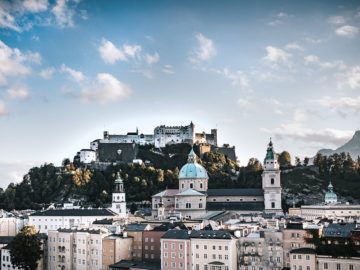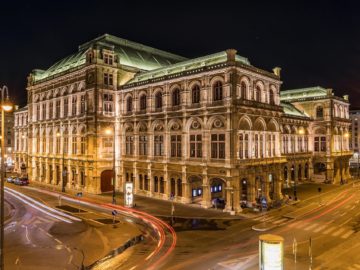Key facts
Austria is a landlocked country located in Central Europe, bordered by Germany to the northwest, Czech Republic to the north, Slovakia to the northeast, Hungary to the east, Slovenia and Italy to the south, and Switzerland and Liechtenstein to the west. It has a population of approximately 8.9 million people and the official language is German.
Austria is known for its mountainous terrain, with the Austrian Alps covering much of the country. It is home to some of the highest peaks in Europe, including the Grossglockner and the Großer Priel. The Danube, Austria’s longest river, flows through the country and is a major transportation corridor.
The population of Austria is predominantly German-speaking, but there are also significant populations of Croatian, Slovenian, and Hungarian speakers. The country has a rich cultural heritage, with a mix of traditional folk music and art, as well as a thriving classical music scene. It is also known for its cuisine, with dishes like wiener schnitzel and strudel being popular internationally.
EF EPI’s 2021 rankings placed Austria 2nd among 100 nations out of non-native English-speaking countries.
The national currency in Austria is Euro (EUR). The euro (€) is subdivided into 100 cent (c).
Austrian
Banknotes
€5€10€20€50€100€200€500
Austrian
Coins
€1€25c10c20c50c1c2c
Check with your bank before your trip to find out if there are any fees for using your card abroad. Some banks do not charge fees when you use a foreign ATM or pay in foreign currency, but others may charge a fixed cost for each transaction or allow a limited number of free withdrawals. The travel card provided by Wise.com, Revolut or Monose might be an excellent option to cut down on transaction fees.
Ookla® Speedtest No data available.
ATM Density Austria has more ATMs than most other countries.168.71 ATMs per 100,000 people.The global average is 39.49.
SIM Registration In order to purchase a SIM card in Austria, a passport or ID is required as identification.
Socket types
There are 2 socket types used in Austria. Type C is a popular socket type throughout Europe (except the United Kingdom), Russia, and certain Asian countries.
The sockets’ shapes and voltage differ from country to country and a travel plug adapter may be required. Portable devices, such as phones, notebooks or tablets, usually handle the entire range of voltages used across the world (110-240V).
Public holidays
In the year 2024, Austria will celebrate 13 national public holidays. The next one Assumption Day will take place on August 15.
| Date | Holiday name | |
|---|---|---|
| January 1, 2024 | New Year’s DayNeujahr | |
| January 6, 2024 | EpiphanyHeilige Drei Könige | |
| April 1, 2024Moving holiday | Easter MondayOstermontag | |
| May 1, 2024 | National HolidayStaatsfeiertag | |
| May 9, 2024Moving holiday | Ascension DayChristi Himmelfahrt | |
| May 20, 2024Moving holiday | Whit MondayPfingstmontag | |
| May 30, 2024Moving holiday | Corpus ChristiFronleichnam | |
| August 15, 2024 | Assumption DayMaria Himmelfahrt | |
| October 26, 2024 | National HolidayNationalfeiertag | |
| November 1, 2024 | All Saints’ DayAllerheiligen | |
| December 8, 2024 | Immaculate ConceptionMariä Empfängnis | |
| December 25, 2024 | Christmas DayWeihnachten | |
| December 26, 2024 | St. Stephen’s DayStefanitag |
Sources
- EF English Proficiency Index (EF Education First)
- Speedtest Global Index® (Ookla®)
- Automated teller machines (ATMs) (per 100,000 adults) (The World Bank Group)
- Registration Policies Per Country (Prepaid Data SIM Card Wiki)
Tourism
Nature landmarks are also popular attractions in Austria, with the Austrian Alps being a major draw for visitors. The Alps are home to some of the highest peaks in Europe, as well as a variety of outdoor activities, including hiking, mountain biking, and skiing. Another popular natural landmark in Austria is the Wachau Valley, a picturesque region known for its vineyards, castles, and medieval villages.
Austria is also home to several beautiful cities that are worth exploring. Vienna, the capital, is known for its rich history, cultural attractions, and stunning architecture. Other popular cities include Salzburg, known for its Baroque architecture and connection to Wolfgang Amadeus Mozart, and Innsbruck, known for its picturesque location in the Austrian Alps.
There are many unique things to see and do in Austria, including visiting the Vienna State Opera, one of the most famous opera houses in the world, or touring the Carinthian Lakes region, known for its crystal clear lakes and beautiful beaches. You can also visit the natural thermal baths in the town of Baden, or take a scenic drive through the Grossglockner High Alpine Road, a winding mountain pass with breathtaking views. Overall, Austria offers something for everyone, from cultural attractions and natural landmarks to beautiful cities and unique experiences.
What hotel chains are present in Austria?
There are Mariott hotels in Vienna.
The Hilton hotel chain operates in Austria.
The IHG hotel chain operates in Austria.
The Best Western hotel chain operates in Austria.
There are Radisson hotels in 3 cities.
The Accor hotel chain operates in Austria.
Local delicacies and must-try foods and drinks in Austria
- Wiener Schnitzel (veal cutlet):
A thin, breaded and fried veal cutlet that is a national dish in Austria. It is often served with a side of potatoes or rice and a salad. - Tafelspitz (boiled beef):
A traditional dish made from boiled beef, served with a variety of vegetables and sauces. - Goulash (meat and vegetable stew):
A hearty stew made with beef, vegetables, and spices, often served with dumplings or bread. - Apfelstrudel (apple strudel):
A dessert made with thin layers of flaky pastry filled with sliced apples, raisins, and spices, often served with vanilla sauce or whipped cream. - Kaiserschmarrn (shredded pancakes):
A dessert made with shredded pancakes, served with caramelized apples or fruit compote. - Sachertorte (chocolate cake):
A chocolate cake with a layer of apricot jam in the middle, topped with chocolate icing.
Austria is also known for its wines, with the wine-growing regions of the Wachau Valley and the Kamptal producing some of the country’s finest vintages. The country is also known for its beer, with the cities of Salzburg and Linz being home to some of the country’s oldest breweries. In addition, Austria is known for its brandies, including schnapps and pálinka.
What fast food chains are present in Austria?
The McDonald’s chain operates in Austria.
The KFC chain operates in Austria.
The Burger King chain operates in Austria.
The Subway chain operates in Austria.
The Domino’s Pizza chain operates in Austria.
The Starbucks chain operates in Austria.
Sources
- Country by National Dish (Samson Daniel)
Weather
What is the climate like in Austria?
In the eastern part of Austria, the climate is more continental, with hot summers and cold winters. The average temperature in the summer is around 28°C (82°F), while in the winter it can drop to around -5°C (23°F). In the western part of the country, the climate is more Mediterranean, with mild winters and hot summers. The average temperature in the summer is around 30°C (86°F), while in the winter it can drop to around 7°C (45°F).
Overall, Austria experiences a wide range of weather and climate conditions, with hot summers and cold winters in the lowland areas, and extreme weather conditions in the mountain regions.
When is the best time to visit Austria?
Some examples of events that take place in the summer include the Salzburg Festival, a renowned classical music and drama festival held in the city of Salzburg; the Donauinselfest, the largest open-air music festival in Europe; and the Viennale, an international film festival held in Vienna. There are also a number of art and music festivals held in smaller towns and villages throughout the country.
In addition to these events, the summer is also a great time to visit Austria for sightseeing and cultural experiences. You can visit the country’s many castles and palaces, take a scenic drive through the Austrian Alps, or visit the many museums and galleries in the cities. Overall, the summer is a great time to visit Austria if you are interested in experiencing the country’s rich cultural heritage and natural beauty.
What is the weather like in Vienna?
Weather data for Vienna (capital city) by Open-Meteo.com
Transport
How easy is it to get around Austria by train?
Austria does have high-speed railways, with the Railjet service connecting major cities in the country at speeds of up to 230 kilometers per hour (143 miles per hour). The most popular rail connections in Austria include the routes between Vienna and Salzburg, Vienna and Innsbruck, and Vienna and Graz.
Overall, the rail service in Austria is reliable and of good quality. The trains are modern and well-maintained, with a range of amenities and services available on board. However, some people do complain about the cost of rail travel in Austria, which can be relatively expensive compared to other modes of transportation.
How easy is it to get around Austria by car?
There are also plans to extend the A1 expressway to the south, towards the Croatian and Slovenian borders. In addition to the A1, there are several other expressways in Austria, including the A2, A3, and A4. These expressways connect the major cities and regions in the country and are important transportation corridors.
Most of the expressways in Austria are toll roads, with a system of electronic toll collection in place. However, there are also some smaller roads and highways that are free to use.
Overall, the roads in Austria are well-maintained, both in the cities and in rural areas. The country has a strong infrastructure and invests heavily in maintaining its roads and highways. However, like any country, there may be occasional roadworks or construction projects that cause delays or disruptions to traffic.
Railways There are passenger trains , and some of them are high-speed trains.
Subway Systems The subway system is available in Vienna.
Sources
- List of high-speed railway lines (Wikipedia)
- List of metro systems (Wikipedia)
- Left- and right-hand traffic (Wikipedia)
- The Global Enabling Trade Report 2016: Road connectivity (World Economic Forum)
Safety
Emergency phones in Austria
Sources
- Austria Travel Advisory (United States: Department of State)
- Travel Advice for Austria (United Kingdom: The Foreign, Commonwealth & Development Office)
- Mortality caused by road traffic injury (The World Bank Group)
- Corruption & Economic Crime (United Nations Office on Drugs and Crime)
Smoking & Alcohol
Smoking ban Smoking is forbidden in all public indoor locations, with limited exceptions.
Cananbis legality Recreational usage is decriminalized, and medical use is legal in certain circumstances.
You are not entitled to a duty-free allowance for tobacco or alcohol if you are under the age of 17.
Alcohol allowance
Travellers from EU countries:
- 90L of still wine (60L of sparkling wine)
- 110L of beer
- 10L of alcoholic beverages stronger than 22%
- 20L of fortified or sparkling wine or other liqueurs up to 22%.
Travellers from non-EU countries:
- 4L of wine
- 16L of beer
- 1L of spirits over 22% volume or 2L of alcoholic beverages less than 22% volume
Tobacco allowance
Travellers from EU countries:
- 800 cigarettes or 400 cigarillos or 200 cigars or 1kg of tobacco
Travellers from non-EU countries:
- 200 cigarettes or 100 cigarillos or 50 cigars or 250g of tobacco
Sources
- Federal Ministry of Finance of Austria
- Alcohol, tobacco, cash and excise duties (europa.eu)
- List of smoking bans (Wikipedia)
- Legality of cannabis (Wikipedia)



